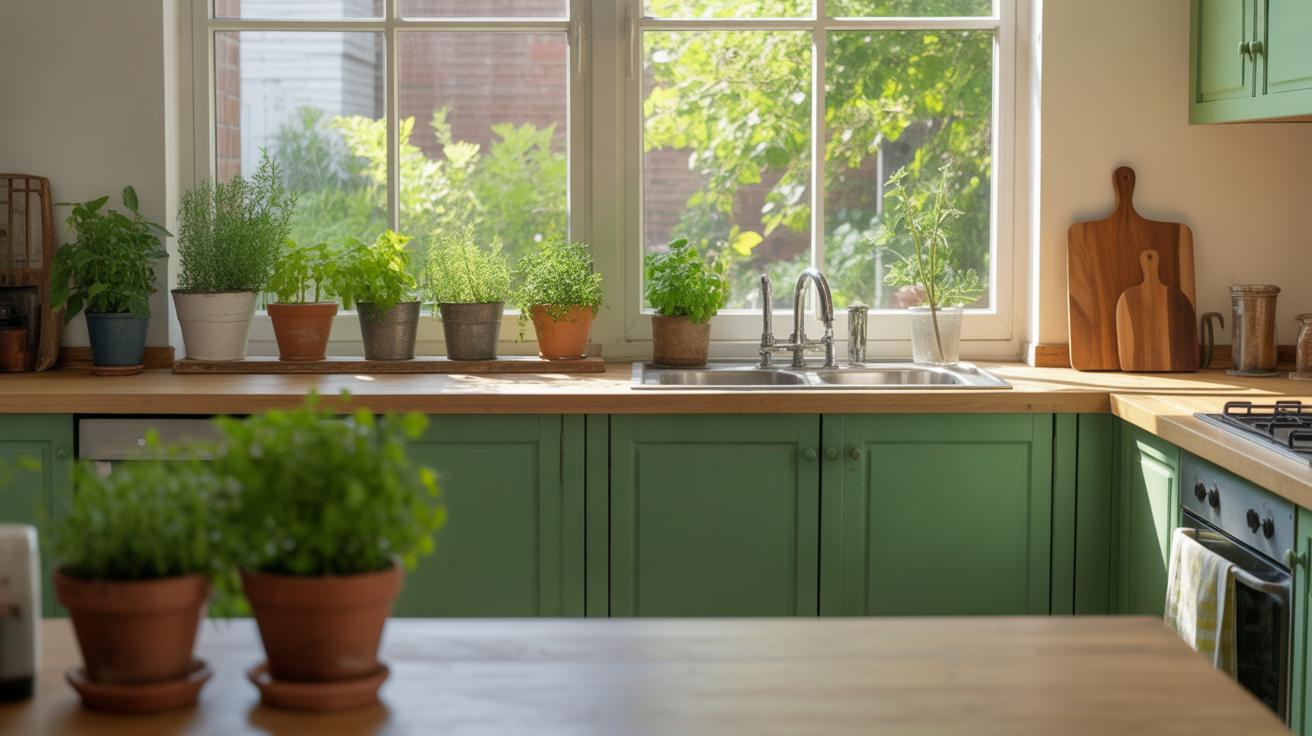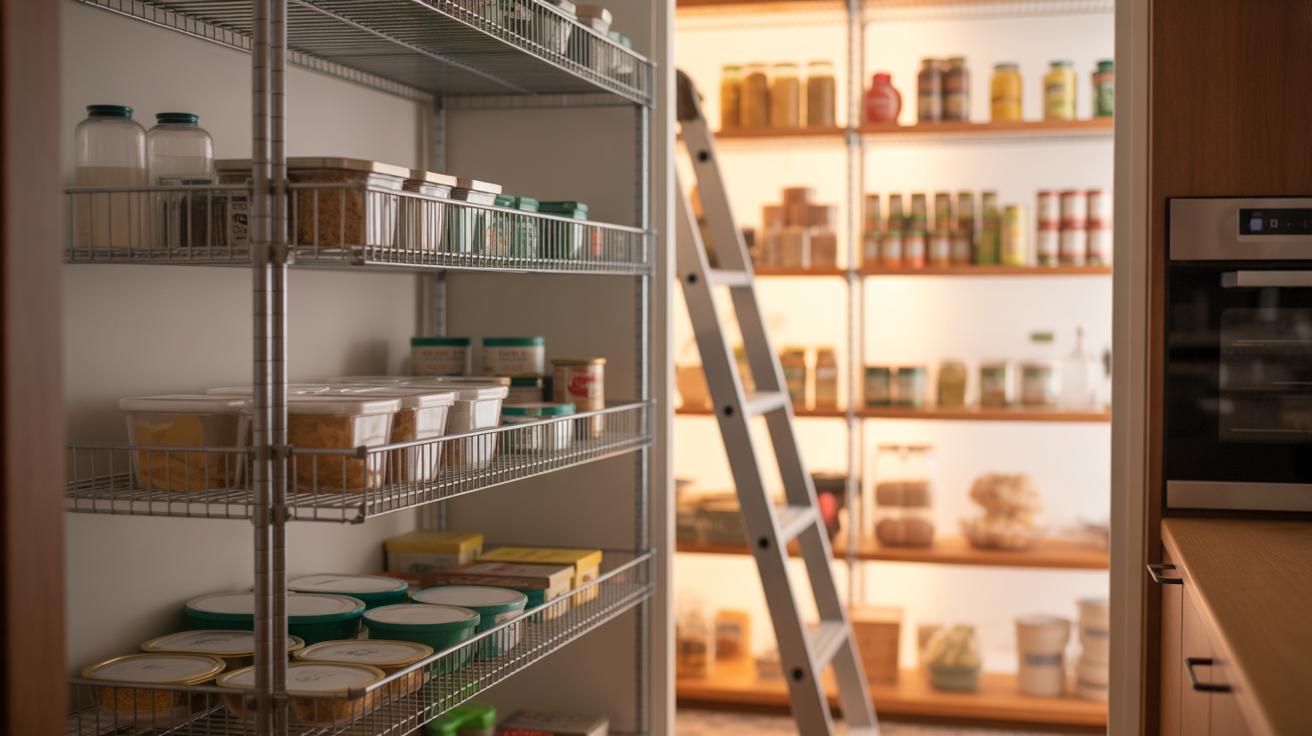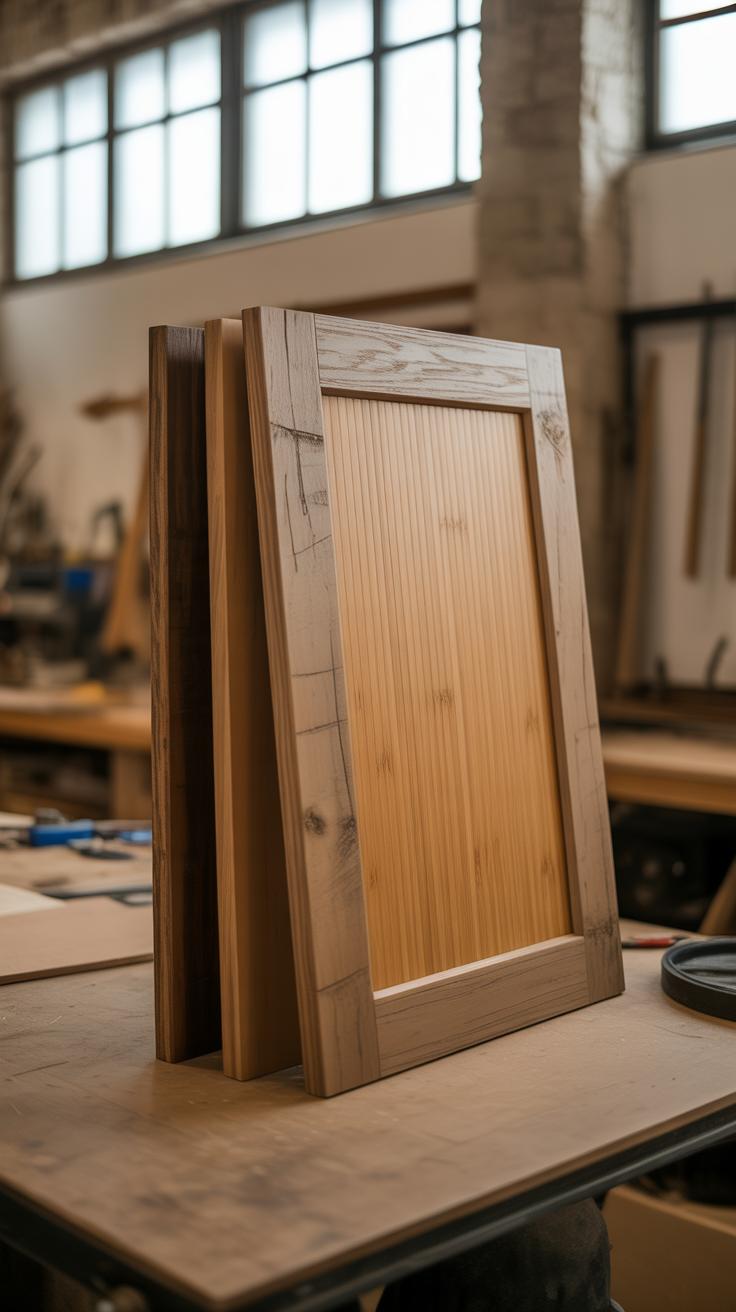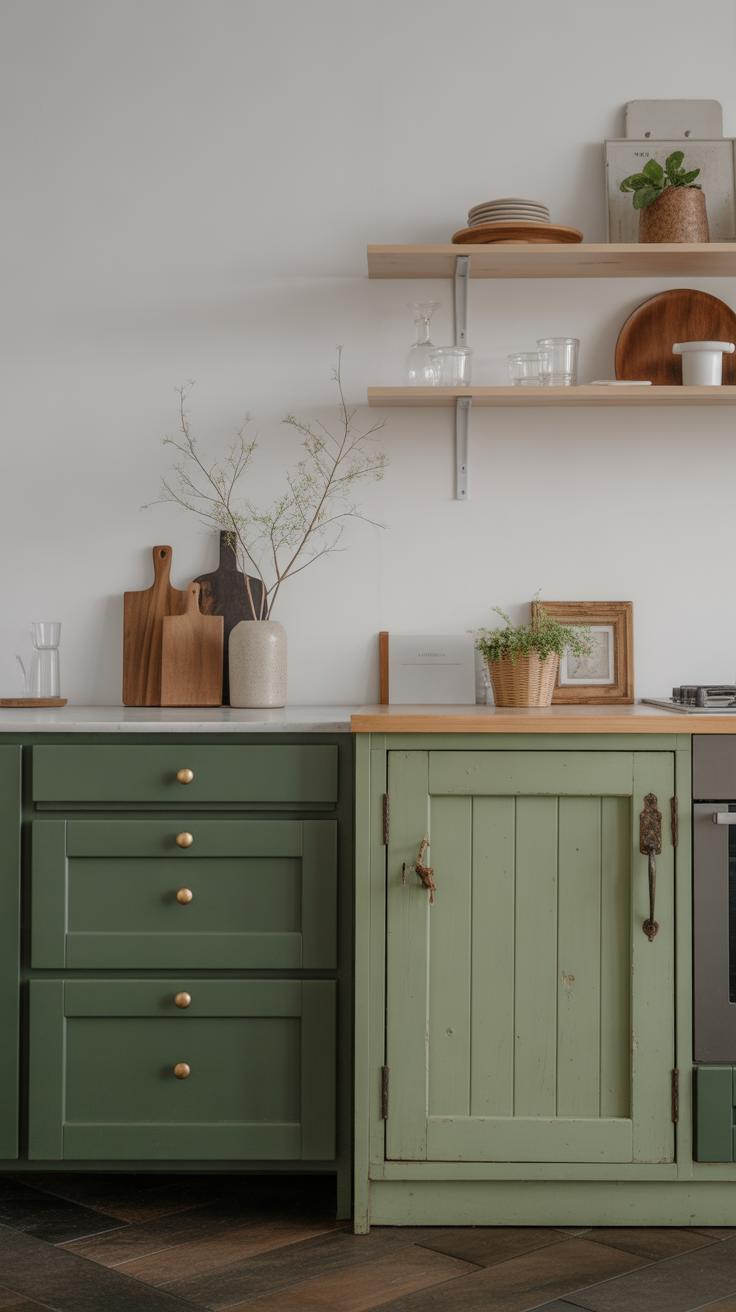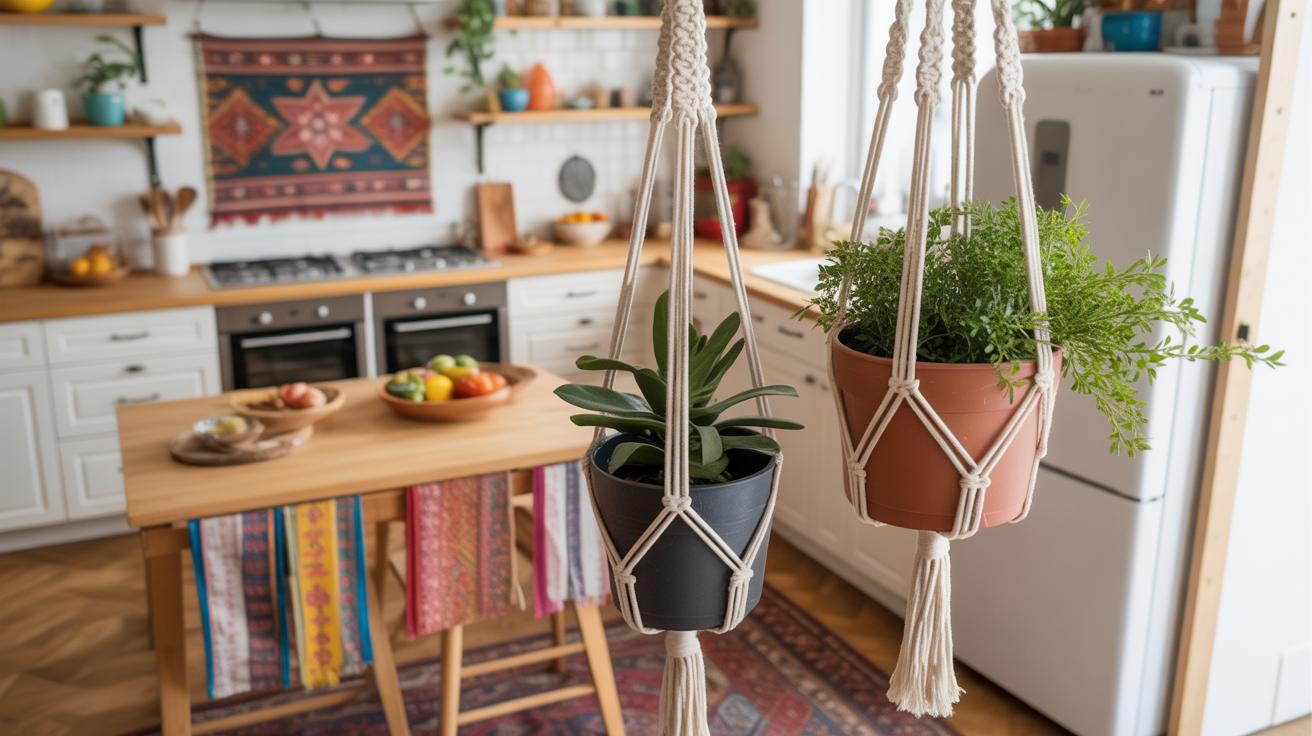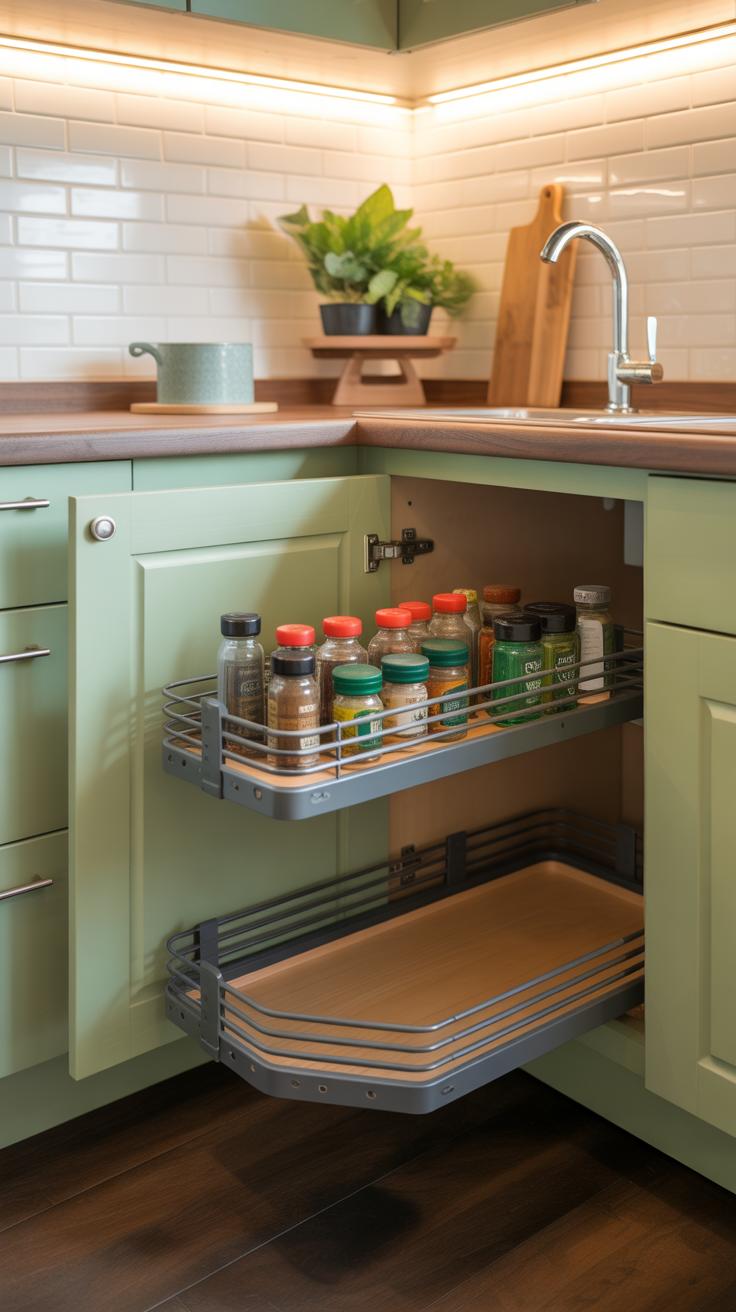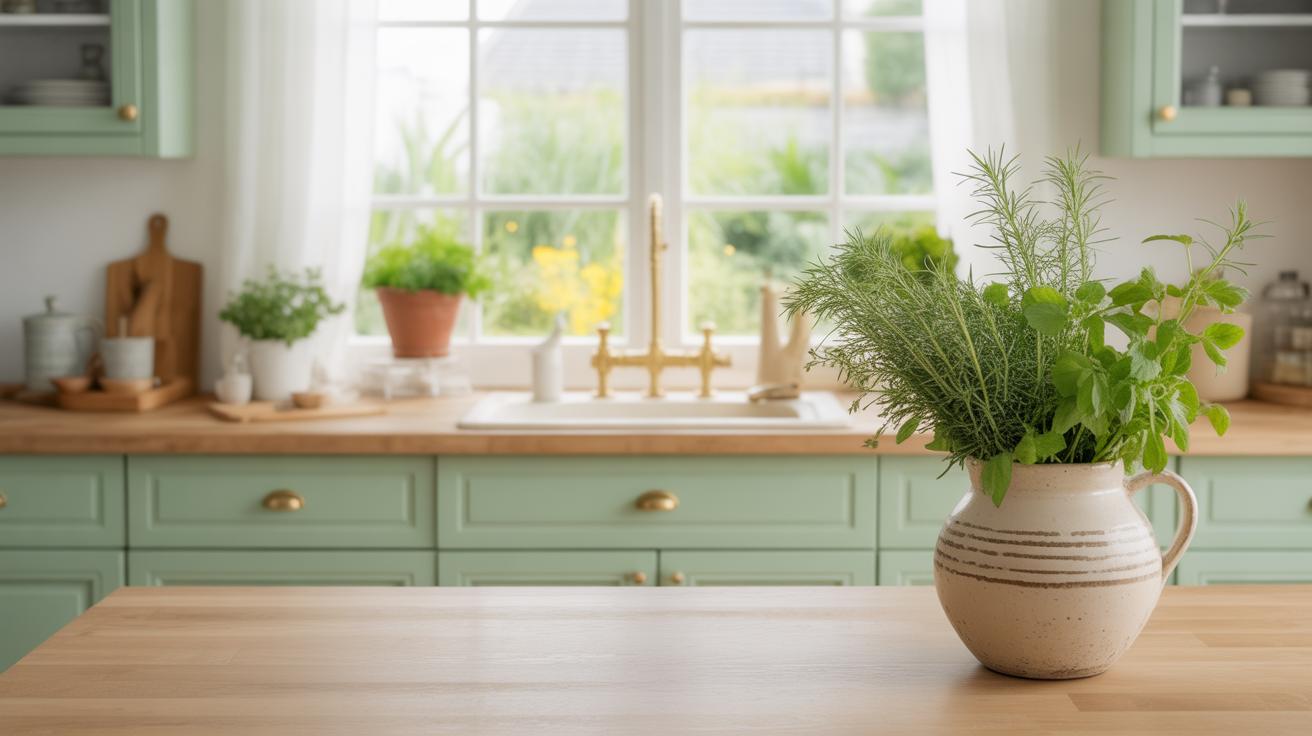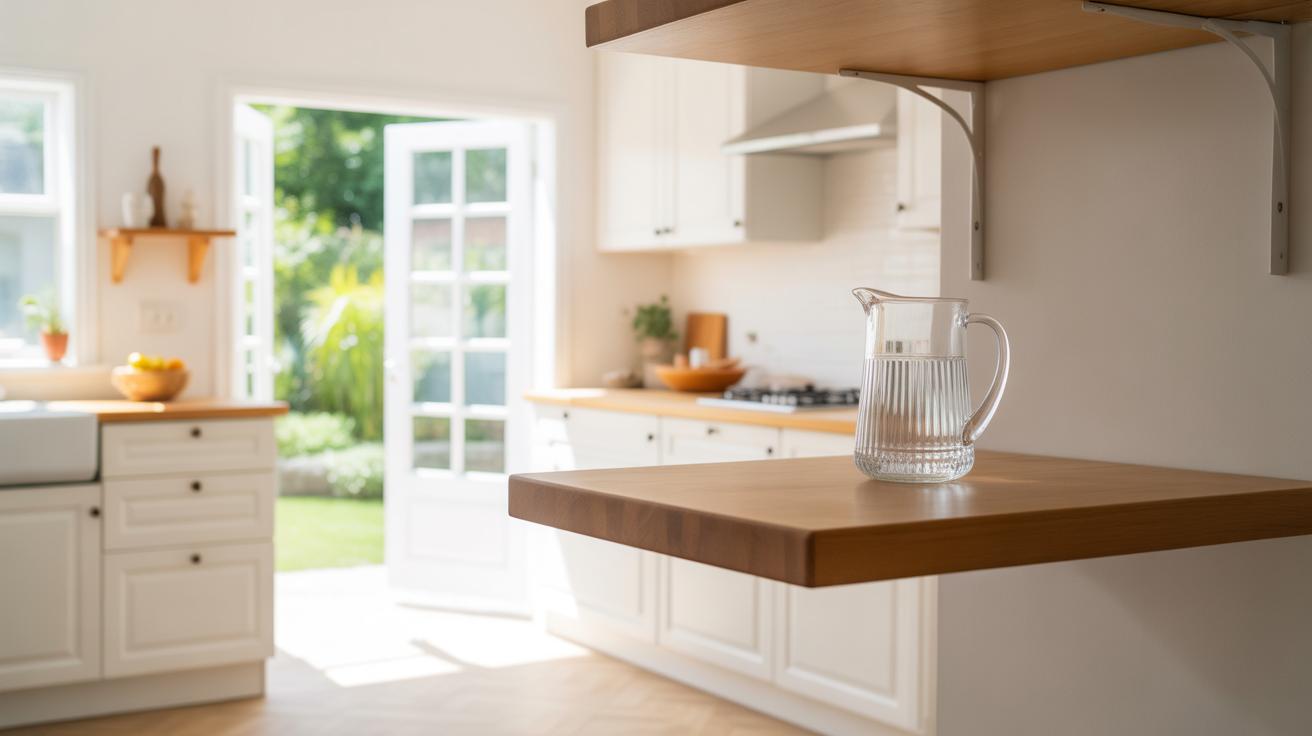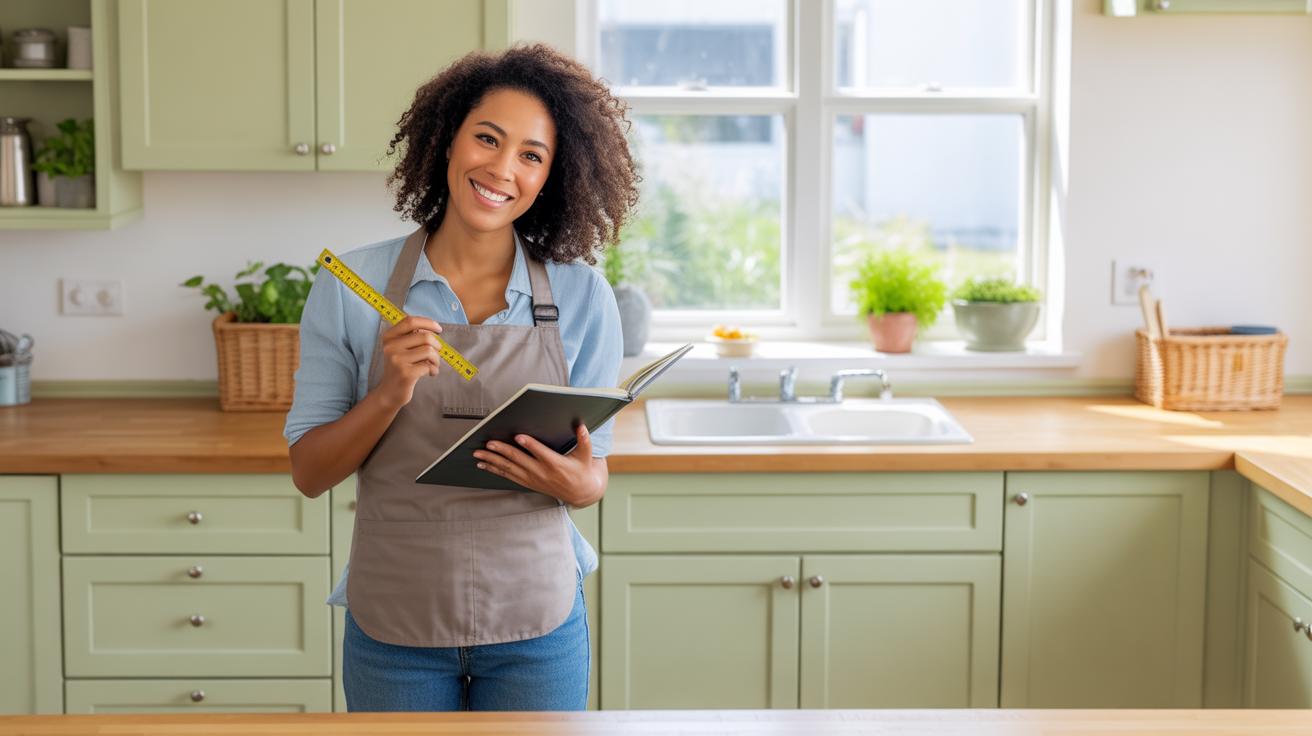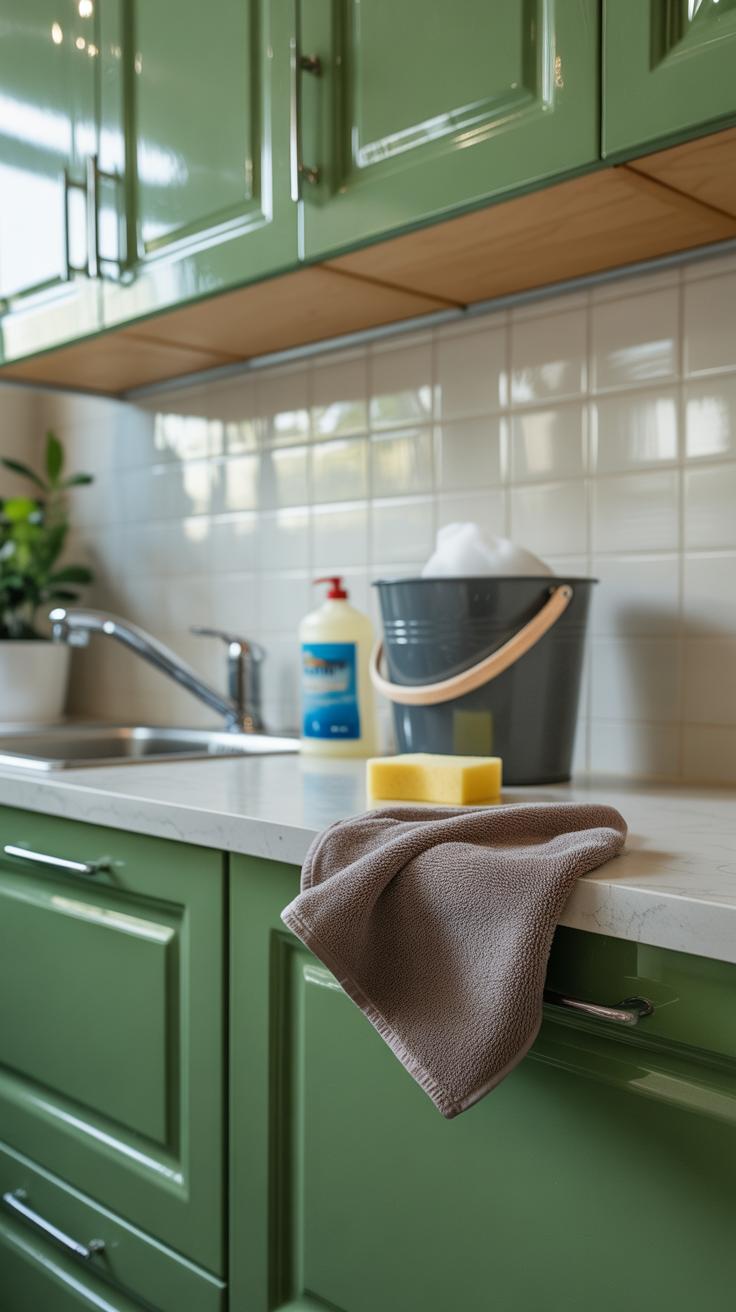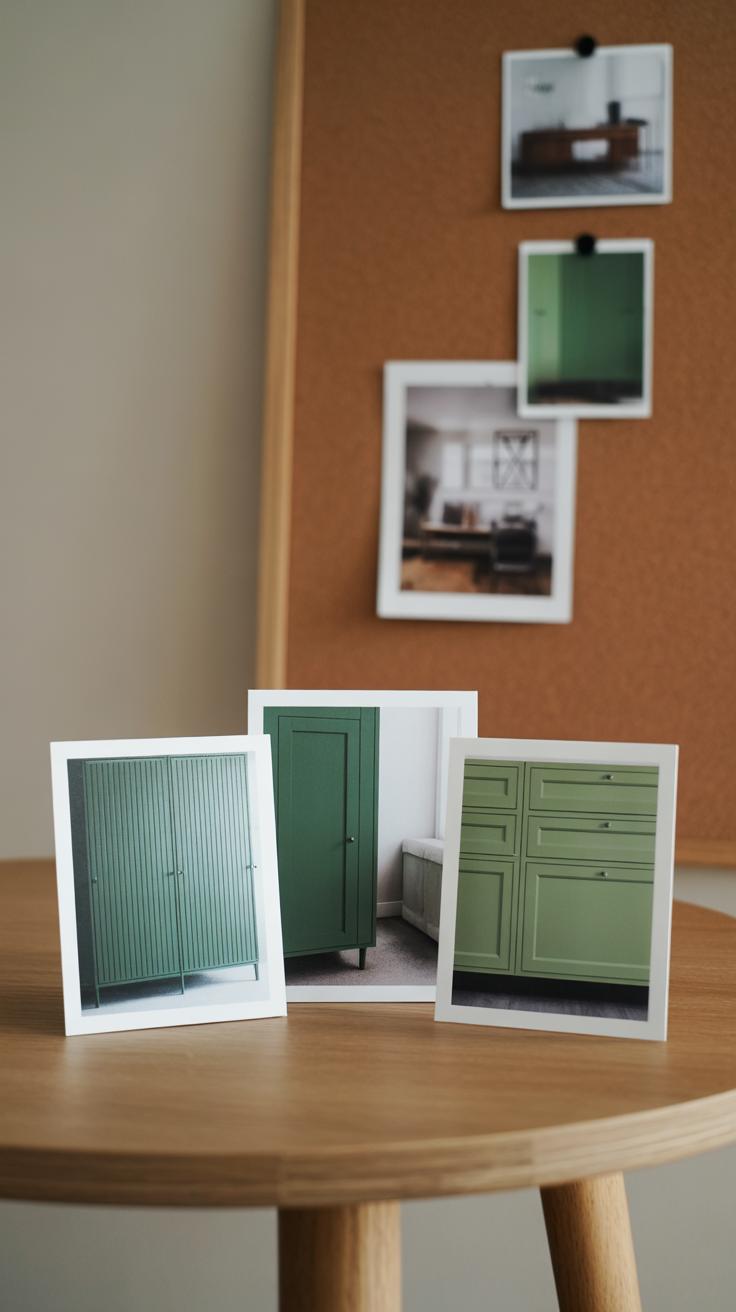Introduction
Green kitchen cabinets bring both style and sustainability to your home. Choosing green doesn’t only refer to the color but extends to making environmentally responsible decisions when picking your cabinetry. Green cabinets offer a fresh and unique look while supporting eco-friendly living. This article explores inspirations and ideas for bringing green kitchen cabinets into eco-friendly homes effectively.
You will learn the benefits of green kitchen cabinets, how to select eco-friendly materials, and ways to care for your cabinets sustainably. Let’s dive into how your kitchen can become a space that reflects your commitment to the environment, all while adding charm and function.
Understanding Green Kitchen Cabinets
Definition of Green Cabinets
Green kitchen cabinets can mean two things: their color and their environmental impact. When you think of green cabinets, maybe you picture shades ranging from soft sage to deep forest hues. These colors bring a kind of calm and natural vibe to your kitchen. But beyond aesthetics, green cabinets also refer to those crafted with eco-conscious principles in mind.
This means materials and finishes that reduce harm to the planet. For instance, cabinets made from reclaimed wood or low-VOC paints qualify as green because they minimize pollution and waste. So, green isn’t just a color here—it’s a choice about how your kitchen affects the environment.
How Green Cabinets Fit in Eco Friendly Homes
If you aim to live more sustainably, green cabinets are a smart step. They contribute by cutting down the use of toxic chemicals and preserving natural resources. Your kitchen, after all, is one of the most used spaces and can create a surprisingly large carbon footprint. Choosing green cabinets can reduce that impact.
You might wonder: does picking green cabinets limit style or variety? Not really. Many companies now offer beautiful options that are both stylish and responsible. Plus, these cabinets wear well over time, meaning fewer replacements and less waste. So, green cabinets subtly support a healthier home and planet every day.
Choosing Eco Friendly Materials for Cabinets
When picking materials for your green kitchen cabinets, the source and makeup matter a lot more than you might think. Woods harvested from sustainable forests offer a better option because these forests are managed to prevent over-logging and to support biodiversity. Look for certifications like FSC (Forest Stewardship Council) or PEFC (Programme for the Endorsement of Forest Certification) on your wood products. They signal that the wood comes from responsibly managed sources—though, honestly, not every label guarantees what it promises, but they’re a good starting point.
But it’s not just about traditional wood. Bamboo, for instance, grows fast and can be harvested without killing the plant, making it an interesting alternative. Reclaimed wood is another choice that feels good—you’re reusing materials that otherwise might end up as waste. Sometimes, reclaimed wood carries a unique character because of its past life, though that might not always suit everyone’s taste.
Then there are recycled composite materials made from wood fibers or plastics. These can reduce demand for virgin wood, but some contain binders or resins you might want to investigate, especially if you’re concerned about indoor air quality. It’s a bit of a balancing act, deciding what aligns with your values and needs.
What’s clear though: choosing eco-friendly materials for your kitchen cabinets means thinking beyond looks. It’s about where these materials come from, how they were processed, and, to some extent, what kind of story they tell in your home.
Color Choices for Green Cabinets
Choosing the right shade of green for your kitchen cabinets can really change the whole atmosphere. Green is natural and soothing, but it’s a wide spectrum—from soft pastels to deep forest tones. You want a shade that not only brightens the space but also fits into your eco-friendly theme. For example, lighter greens can make a kitchen feel more open and airy, which might be good if you’re working with a smaller area or limited natural light. On the other hand, darker greens can create a cozy, grounded feeling, which some people really appreciate for their home.
Popular Green Shades
Some green shades stand out because they blend style with that earthy vibe:
- Sage Green: A muted, grayish green that feels calm and pairs well with natural wood and stone.
- Olive Green: Earthy and strong, it adds depth without being overpowering.
- Mint Green: A fresher, lighter tone with a subtle brightness that helps keep the kitchen lively.
- Hunter Green: Dark and rich, great for making a statement while still feeling organic.
- Celadon: A soft, pale green with a slightly blue tint that can refresh the space without being too bold.
Each of these colors can shift how you experience your kitchen, so it’s worth testing small samples before deciding.
Matching Green Cabinets with Kitchen Decor
Matching green cabinets isn’t just about the color itself; it’s about how it interacts with your other kitchen elements. For instance, sage green pairs nicely with warm wooden countertops and brass hardware—a combo I saw once that felt simultaneously rustic and modern. Mint green tends to work well in kitchens with bright white walls and cool stainless steel appliances, making the space feel crisp and clean.
If your kitchen has darker floors or darker countertops, olive or hunter green cabinets can bring an unexpected contrast that’s surprisingly harmonious. It’s interesting that these richer greens work well with neutral tiles or stone backsplashes, grounding the space without stealing focus. Pairing celadon cabinets with light gray walls and natural fiber rugs can create a subtle, calming environment, which some folks might find ideal for winding down during a busy day.
Ultimately, the shade of green you choose can define the vibe of your kitchen. The trick is balancing your green hues with complementary textures and tones—what do you find yourself naturally drawn to? Maybe the green that feels too bright at first glance ends up being your favorite because it lifts your mood each morning.
Design Styles Featuring Green Cabinets
Modern and Minimalist Kitchens
Green cabinets can fit surprisingly well in modern, minimalist kitchens. The clean lines of sleek cabinetry get an unexpected lift with a muted or deep green. The color brings a softness that contrasts with the usual stark whites and grays. Sometimes, that subtle twist is all your kitchen needs to feel fresh without overwhelming the calm vibe.
Think about pairing green cabinets with simple hardware—perhaps matte black handles or no handles at all. This keeps the space uncluttered while letting the green do some quiet work. You might find that the color’s natural feel adds warmth, making the kitchen less cold, even though the design remains very simple.
Have you noticed how green tones can create a visual anchor without stealing the show? It’s like they ground the entire room. And since modern designs often spotlight sustainability, green cabinets can underline your eco-conscious choices just by their presence.
Rustic and Traditional Kitchens
Green cabinets bring a certain charm to rustic and traditional kitchen settings that’s hard to beat. They evoke nature in a way that wood finishes alone might miss. When paired with distressed wood, open shelving, or antique details, green cabinets feel like a natural extension of the outdoors.
In these spaces, you don’t have to worry about precision. Slightly uneven paint or a matte finish enhances that cozy, lived-in feeling. It’s as if the cabinets have been there for a while, quietly aging alongside the kitchen itself.
If you’re thinking about warmer or olive greens, they blend really well with natural stone countertops or classic tiles. It makes the kitchen feel like it belongs right where it is. Plus, it’s fun to see how green cabinets can brighten up an older traditional kitchen, giving it a fresh but respectful update.
Improving Kitchen Function with Cabinet Features
Green kitchen cabinets can do more than just bring a splash of color and an eco-friendly vibe to your space—they can make your kitchen genuinely easier to work in. Think about smart storage features that actually save you time and stress. Pull-out shelves, for example, let you access items at the back without awkward bending or reaching. It’s one of those small changes that makes you wonder why more kitchens don’t have them.
Lazy Susans aren’t just for cramped corners; they help utilize awkward spaces efficiently, keeping spices or small jars visible and within reach. And deep drawers? Perfect for pots and pans, but they work surprisingly well for organizing bulky food containers too.
When it comes to materials, durability matters a lot, especially for cabinets meant to last through years of cooking chaos. Choosing solid wood or recycled composite panels can reduce waste because you won’t need to replace them frequently. But keeping green cabinets looking good over time is a balancing act. I’ve found gentle cleaning with mild soap keeps the finish intact without harsh chemicals that could harm eco-friendly paints or varnishes.
Maybe you wonder if these features complicate the overall style—but they don’t have to. Ultimately, it’s about finding the balance between practical usability and sustainable choices, and honestly, it’s worth experimenting until you find what fits your kitchen rhythm best.
DIY and Budget Friendly Green Cabinet Ideas
Giving your kitchen cabinets a green makeover doesn’t have to break the bank or create too much waste. If you already have cabinets, painting them can be a surprisingly good option. Start with a thorough cleaning to remove grease and dirt—skip this step, and the paint might peel off sooner than you want. Sand the surfaces lightly to help the paint stick, then apply a primer designed for kitchen use. When choosing green paint, look for low-VOC or zero-VOC options; they’re better for indoor air quality and, well, they fit the eco-friendly vibe better.
Use a roller or brush in thin layers, waiting a few hours between coats. Don’t rush it; patience here pays off. It’s not just about color—think about how the finish will stand up to moisture and daily wear. Satin or semi-gloss finishes usually work best.
If painting feels limiting, consider building cabinets from reclaimed wood or other recycled materials. Salvaged wood often carries character—knots and marks that add personality. Try checking local salvage yards, construction sites, or even old furniture you might find discarded. Sometimes, community groups or online marketplaces have hidden gems at low prices or free.
Once you have your materials, simple designs reduce costs and complexity. You don’t need intricate details—basic box-style cabinets can still look great when painted or stained green later. Keep in mind that not every piece of reclaimed wood will be perfect, so be prepared for a bit of repair or customization. It can be a bit of a puzzle, but it makes you appreciate the process.
Could there be a better mix of style, savings, and sustainability than refreshing your own cabinets or reimagining reclaimed wood? Even if you’re a bit hesitant about DIY, small steps like these might be more doable than you expect.
Incorporating Energy Efficiency in Kitchen Design
Green kitchen cabinets can be more than just a color choice or an eco-friendly material—they can be a key part of designing a kitchen that uses less energy overall. For example, choosing cabinetry made from sustainably sourced wood or recycled materials reduces the energy footprint right from the start. But then, think about how these cabinets interact with other kitchen elements.
When these cabinets are paired with thoughtful layout decisions, like positioning near natural light sources, they help reduce the need for artificial lighting. Also, cabinet doors that close softly and seal properly can minimize drafts and even help maintain indoor temperatures, keeping your kitchen more comfortable without cranking the heating or cooling.
It’s surprising how much a small detail like cabinet placement affects energy use. Sometimes, it’s worth asking—could your cabinet choices shape how your kitchen breathes and functions? I found that planning with energy in mind makes the whole space feel smarter, not just greener on the surface.
Lighting Solutions for Cabinets
Lighting inside and around cabinets is often overlooked but can have a big impact. Switching to LED lights is a no-brainer. They use a fraction of the power of traditional bulbs and last much longer.
Consider strip LEDs tucked under cabinets or motion-sensor lights inside deep cupboards. These options save energy because they only activate when needed, avoiding light left on by accident. I’ve seen setups where cabinet lighting shines softly in the evening, providing just enough visibility without flooding the room.
There are warm and cool tones to choose from, which affects mood and usefulness—but keeping consumption low should be the main goal. Plus, since LEDs run cooler, they don’t add unwanted heat to the kitchen, which might otherwise force your AC to work harder.
Appliance Integration with Cabinets
Fitting appliances into cabinets is not just about aesthetics. It’s about making kitchens more practical and reducing wasted space. Built-in microwaves, compact dishwashers, or panel-ready refrigerators can all hide behind cabinet fronts, creating a cleaner look and often a more compact overall kitchen footprint.
Less wasted space means less room for extra appliances, which sometimes means less energy use overall. Also, built-in appliances tend to be newer models that come with better energy ratings. Embedding these devices helps keep everything organized, so nothing overheats or runs unnecessarily long because you forgot to switch something off.
While it might seem easier to have separate countertops and freestanding appliances, embedding them in cabinetry can actually contribute to a kitchen’s overall energy-conscious design—and that’s definitely something worth thinking about when you plan your green kitchen.
Benefits of Eco Friendly Kitchens Beyond Cabinets
Green cabinets can set the tone for an eco-conscious kitchen, but they’re just one piece of the puzzle. To create a truly sustainable space, you might want to think about what’s underfoot and on your countertops. For example, countertops made from recycled glass or reclaimed wood pair beautifully with green cabinets, adding texture and keeping waste out of landfills. Bamboo surfaces are another option—they grow quickly and bring a natural vibe without extra environmental strain.
Flooring matters too. Cork and reclaimed hardwood floors often slip under the radar but work well to complement green cabinetry. Both offer renewability, and cork feels soft and warm—a nice contrast to harder materials. Plus, these floors tend to age gracefully, which means less replacement and less waste over time.
Eco Friendly Countertops and Flooring
Picking sustainable materials for countertops and floors isn’t just about appearances—it’s practical. Think about:
- Concrete with recycled content, giving an industrial-chic look while using less new concrete.
- Recycled aluminum or stainless steel counters, which resist stains and last long.
- Linoleum flooring made from natural materials like linseed oil and wood flour, biodegradable and low in toxins.
These options tend to hold up well, which can push back the time before you need new surfaces. They also can be easier to clean, meaning fewer harsh chemicals to worry about.
Water and Waste Efficiency
Water use often flies under the radar when planning a kitchen makeover. You might wonder if those shiny faucets truly make a difference. Low-flow faucets and aerators can cut water use without a noticeable change when washing. Dual-flush toilets in nearby areas also reduce water demand, though not directly in the kitchen.
Managing waste too—sorting recyclables right at the source, composting food scraps—can really shrink your kitchen’s footprint. Some kitchens even incorporate built-in compost bins to keep things tidy and encourage habit-building. It’s a small step with tangible impact. You might find it surprisingly satisfying, turning scraps into soil rather than trash.
Maintaining Your Green Kitchen Cabinets
Keeping green kitchen cabinets looking fresh isn’t always simple, but it’s definitely doable without harming the environment. You might find that the usual cleaners around the house are too harsh — they can dull the finish or even wear down the paint over time. Instead, reaching for non-toxic products helps preserve both your cabinets and your indoor air quality. Gentle mixes of vinegar and water or mild castile soap with warm water work well. I’ve tried diluted lemon juice once for a spot treatment, and it brightened things up without damage.
Some cleaning tips worth considering:
- Use a soft cloth or sponge to avoid scratches on delicate surfaces.
- Wipe spills quickly to prevent stains or paint lifting.
- Skip abrasive scrubbers that might wear your finish unevenly.
Now, should you notice chips or scratches? You don’t have to replace entire cabinet doors right away. Simple repair kits made from plant-based materials or natural oils can restore color and seal minor imperfections. I once sanded a rough edge lightly and applied a beeswax-based finish; the cabinet door looked almost new. It’s a slower process than throwing out and buying new, but it genuinely keeps things sustainable—and maybe saves you a bit of stress.
Refinishing is another option, though it calls for patience. Low-VOC or water-based paints are good choices when refreshing the color or finish. Just keep in mind, small repairs often prevent larger problems later. Would you go for a full refinish straight away? Or try patching things up first? The answer depends on your kitchen’s wear and your willingness to spend time on upkeep.
Inspiring Green Kitchen Cabinet Examples
Green kitchen cabinets can shift the whole vibe of your kitchen, but what does that look like in real life? Think about a small kitchen where space is tight—using soft sage green cabinets paired with light wood shelves can open things up, almost like bringing a bit of nature indoors. One homeowner I know paired their green cabinets with white countertops and natural wicker baskets. It wasn’t perfect, but it created an earthy, calming feel without feeling too forcing.
For compact kitchens, consider darker greens like forest or olive green—but only if your kitchen gets a good amount of natural light. You want to avoid making things feel cramped. Reflective or matte finishes can play with light differently, and that choice really changes your mood. Have you thought about mixing green cabinets with open shelving rather than full upper cabinets? It often frees up the visual space and adds a touch of casual elegance.
Now, when you think about larger kitchens or open plan designs, green cabinets can take on a bolder role. Deep emeralds or vibrant moss tones work well when you have the space to balance them with neutral floors or walls. I’ve seen green kitchen islands serve as a statement piece in open layouts, surrounded by lighter cabinetry or metal accents. There’s this subtle confidence to those choices that’s hard to copy but easy to admire.
Do you prefer an all-green kitchen or just certain sections? Splitting green cabinetry between lower cabinets and an island or a corner pantry might offer enough color without overwhelming the room. It’s worth experimenting because sometimes less is more, yet sometimes more is exactly what you need.
Conclusions
Green kitchen cabinets offer a powerful way to combine aesthetics with sustainability. By choosing cabinets made from eco-friendly materials, you reduce your environmental footprint while enhancing your kitchen’s style. Throughout this article, we examined practical tips on selecting and maintaining green cabinets that align with eco-conscious values.
Your kitchen can be both beautiful and kind to the planet. Small choices like these add up to significant benefits over time. Consider making green kitchen cabinets the heart of your eco-friendly home and enjoy the harmony of function, fashion, and environmental care.

